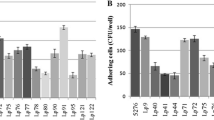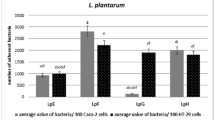Abstract
Bacterial adhesion is a complex phenomenon implicated in the host-bacterial interaction that is pivotal for probiotic activity. Eight probiotic lactobacilli candidates (Lactobacillus reuteri, L. plantarum, L. mucosae, L. murinus) were screened for their ability to adhere to abiotic and biotic surfaces in vitro. Adhesion to hydrocarbons was used for hydrophobicity assessment. Three strains of L. reuteri and L. murinus C were evaluated as hydrophobic, others as intermediate. All tested strains were able to form the biofilm on polystyrene. L. mucosae D and L. reuteri E were tested for adhesion to epithelial cell lines (HeLa and Caco-2). Both were more adherent to HeLa than to Caco-2. The adhesivity degree in HeLa reached the highest value after 8 h of co-cultivation in both lactobacilli tested, then decreased. In Caco-2, adhesion was increased within 24 h from the beginning of the co-cultivation. Mucus-binding protein gene, implicated in adhesion, was detected in L. mucosae D. Therefore, the involvement of proteinaceous substances in binding process was investigated. Cells of L. mucosae D were digested by three proteolytic enzymes (proteinase K, pronase E, trypsin) and evaluated for time-dependent adhesivity changes to HeLa, Caco-2, and L929 cell lines. Results confirmed that proteins are most likely to play an important role in binding of lactobacilli to eukaryotic cells. One hour after treatment, L. mucosae D was able to overcome the effect of proteolytic cleavage. We assume that it was due to the restoration of its cell-surface binding structures. Co-cultivation of HeLa and L. mucosae D led to protuberance and communication channels formation in eukaryotic cells.
Graphical abstract






Similar content being viewed by others
References
Song M, Yun B, Moon JH, Park DJ, Lim K, Oh S (2015) Korean J Food Sci An 35:551
Lahtinen S, Ouwehand A (2009) Mechanisms of probiotics. In: Lee YK, Salminen S (eds) Handbook of probiotics and prebiotics, 1st edn. Wiley, Hoboken, p 377
Sengupta R, Altermann E, Anderson RC, McNabb WC, Moughan PJ, Roy NC (2013) Med Inflamm 2013:237921
Roos S, Jonsson H (2002) Microbiology 148:433
Jones SE, Versalovic J (2009) BMC Microbiol 9:39
Priha O, Virkajärvi V, Juvonen R, Puupponen-Pimiä R, Nohynek L, Alakurtti S, Pirttimaa M, Storgards E (2014) Curr Microbiol 69:617
Wang Y, Yi L, Zhang Zh, Fan H, Cheng X, Lu Ch (2014) Curr Microbiol 68:575
Vendeville A, Winzer K, Heulier K, Tang CM, Hardie KR (2005) Nat Rev Microbiol 3:383
Oh PL, Benson AK, Peterson DA, Patil PB, Moriyama EN, Roos S, Walter J (2010) ISME J 4:377
Frese SA, Benson AK, Tannock GW, Loach DM, Kim J, Zhang M, Oh PL, Heng NCK, Patil PB, Juge N, MacKenzie DA, Peterson DA, Lapidus A, Dalin E, Tice H, Goltsman E, Land M, Hauser L, Ivanova N, Kyrpides NC, Benson AK, Walter J (2011) PLoS Genet 7:e1001213
Bujňáková D, Kmeť V (2012) Folia Microbiol 57:263
Schillinger U, Guigas C, Holzapfel WH (2005) Int Dairy J 15:1289
Vinderola G, Capellini B, Villarreal F, Suárez V, Quiberoni A, Reinheimer J (2008) Food Sci Technol 41:1678
Kiely LJ, Olson NF (2000) Food Microbiol 17:277
Botes M, Loos B, van Reenen CA, Dicks LMT (2008) Arch Microbiol 190:573
Bilková A, Kiňová Sepová H, Bukovský M, Bezáková L (2011) Vet Med 56:319
Kiňová Sepová H, Dubničková M, Bilková A, Bukovský M, Bezáková L (2011) Braz J Microbiol 42:1188
Bilková A, Dubničková M, Kiňová Sepová H (2013) Acta Fac Pharm Univ Comen 60:1
Májeková H, Kiňová Sepová H, Bilková A, Čisárová B (2015) Folia Microbiol 60:253
Potočnjak M, Pusić P, Frece J, Abram M, Janković Gobin I (2017) Food Technol Biotechnol 55:48
Roos S, Karner F, Axelsson L, Jonsson H (2000) Int J Syst Evol Microbiol 50:251
Theerakittayakorn K, Bunprasert T (2011) Proc World Acad Sci Eng Technol 50:373
Lorca G, Torino MI, de Valdez GF, Ljungh Å (2002) FEMS Microbiol Lett 206:31
Štyriak I, Strompfová V, Štyriaková I, Simonová M, Lauková A (2010) Afr J Microbiol Res 4:2265
Muñoz-Provencio D, Monedero V (2011) J Microbiol Biotechnol 21:197
Yadav AK, Tyagi A, Kumar A, Saklani AC, Grover S, Batish VK (2015) Arch Microbiol 197:155
Bilková A, Kiňová Sepová H, Bilka F, Bukovský M, Balažová A, Bezáková L (2008) Acta Fac Pharm Univ Comen 55:S64
Kiňová Sepová H, Bilková A (2013) Folia Microbiol 58:33
Vinderola CG, Reinheimer JA (2003) Food Res Int 36:895
Thapa N, Pal J, Tamag JP (2004) World J Microbiol Biotechnol 20:599
MacKenzie DA, Jeffers F, Parker LM, Vibert-Vallet A, Bongaerts RJ, Roos S, Walter J, Juge N (2010) Microbiology 156:3368
Acknowledgements
The authors are grateful to the Laboratory of Scanning Electron Microscopy in České Budějovice for processing of specimens and assistance with electron microscopy.
Author information
Authors and Affiliations
Corresponding author
Rights and permissions
About this article
Cite this article
Kiňová Sepová, H., Florová, B., Bilková, A. et al. Evaluation of adhesion properties of lactobacilli probiotic candidates. Monatsh Chem 149, 893–899 (2018). https://doi.org/10.1007/s00706-017-2135-1
Received:
Accepted:
Published:
Issue Date:
DOI: https://doi.org/10.1007/s00706-017-2135-1




